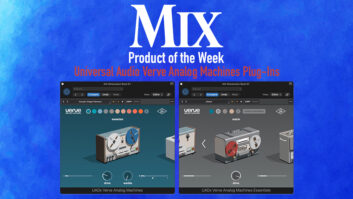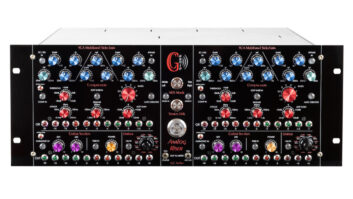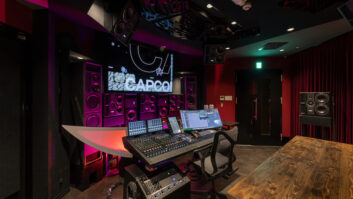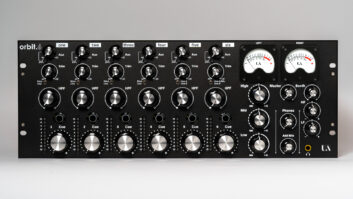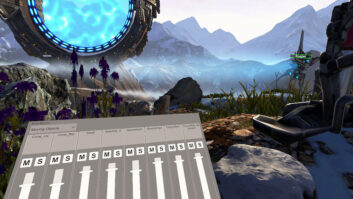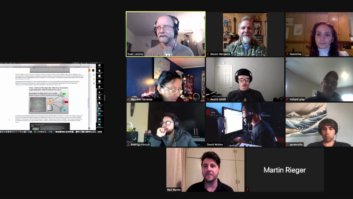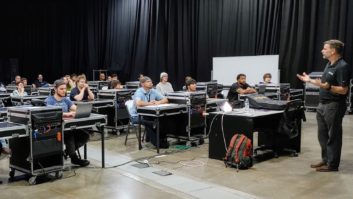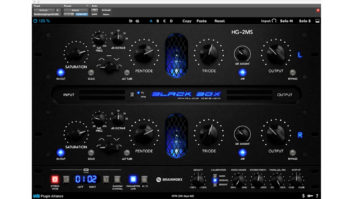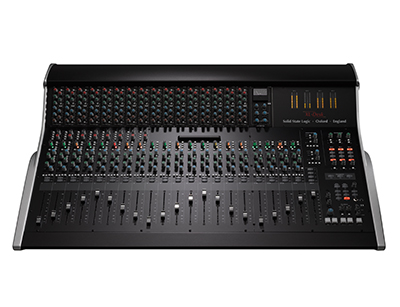
There seems to be a trend for creating music that is akin to building with Legos. Sounds are chosen from vast libraries, divided in bar segments and then copied along to make up a full song. On most mix sessions that come across my desk, dynamics, EQ and effects plug-ins are on everything, and most settings are picked from preset folders. But rather than rant about the glory of analog, I’m using my $100,000 to build a studio.
GROUND CONTROL
The centerpiece of my studio is going to be a fairly sizable console.
Because I’ll be mixing out of the box, I want something that has plenty of physical faders to work on. After weighing up size, budget, customization abilities and sound, I’m installing the new SSL XL Desk ($19,995), which will give me 16 mono and 4 stereo channels. All channels are assignable to four individual mix buses, there’s a stereo cue for headphone mixes during tracking, two additional mono auxiliaries for effects sends, two more stereo return inputs, inserts, and direct outs on each channel.
The coolest feature on this console is that it boasts 18 500 Series slots. You can buy this desk fully loaded with SSL EQs; however, I need more versatility and flavors, so I’m choosing an empty console.
The XL also has a comprehensive monitoring section that allows me to spec two sets of monitors with level control, dim levels and speaker selection. Remember that legendary Phil Collins roomy drum sound? This beast comes equipped with that heavy Listen Room Mic Compressor circuit.
Now let’s load up my 18 500 Series slots!
SOME SIDE DISHES
The XL comes with 16 empty slots. Slots 17 and 18 come fitted with the famous SSL Bus Compressor. This is an extremely useful workhorse compressor, so I’m going to leave that right there.
Eight of the SSL’s channels come equipped with Variable Harmonic Drive preamps. Because I’ll be mostly recording full-band lineups, I’ll need more pre’s. In addition to the SSL slots, I’ve added Rupert Neve Designs’ beefy R6 ($569) rack. This unit will host most of my extra mic preamps.
To add some extra flavor to the eight SSL preamps, I’m choosing Crane Song Syren ($1,200) for its ability to adapt to the sound source. The Rupert Neve Designs 517 ($850) will give me a lot in a small box. It comes armed with a gentle compressor, a mic/DI blend for old-school signal blending straight to track, and the RND Silk tone control. I’m also adding a pair of 512cs ($803.25 x 2 = $1,606.50) for that fat and punchy API sound. The last couple of units in the R6 will be special pre’s: AEA RPQ500s ($584 x 2 = $1,168). The R6 is packed, but I need a few more to complete my recording channels.


The last pre is the Meris 440 ($549). This unit was designed with recording guitar in mind. It features an effects loop so I can record with my favorite pedals in the chain.

I’m adding the Chandler REDD.47 ($2,295), which is a re-creation of Abbey Road’s EMI REDD.51 console valve line amps. It packs a punch and is a no-nonsense box: Input gain, Output, Fine Gain trim and Rumble Filter.
I’m also choosing the brand new Manley Force ($2,250), which is four Manley Core high-voltage tube preamps in one.

UNDER THE HOOD
Before I dive into outboard and microphone selections, let’s have a quick look at what I’ll be using to record.
My DAW will be Pro Tools 11 ($699). “Why not 12?” you ask. Version 11 is now well and truly tested. Pro Tools 12 is imminent and will have some really cool features like the Avid Cloud Collaboration. But for now, I have work to do and can’t lose time being an early adopter to flush out any potential bugs. I’ll get going with a stable system and then upgrade.
The desk has 24 fader inputs, 20 mic pre’s and a few extra ins, so I’m going to need an interface rig capable of handling all this. Universal Audio’s Apollo 16 ($2,999 x 2 = $5,998) will do just that. I’ll get two of those and cascade them, giving me 32×32 analog I/O.
We keep hearing about lower production budgets, labels cutting costs, artists funding the recordings themselves. It all boils down to tighter project timelines. I may find myself mid-mix when I still need to do a bunch of overdubs. That means my console channels are in use, so I’ve added a Rupert Neve Designs 5059 ($3,749) summing mixer. This will give me extra recording power and may also come in handy on complex mixes that fill up the board.
Considering that my console doesn’t have automation and most automation will take place within the DAW environment, I’ve incorporated an Avid Artist Control ($1,499) for multifader and plug-in automation control.
ALL MY DUCKS IN A ROW
To fill the rest of the 500 Series slots on the XL Desk, I’ve picked a selection of mix tools: EQs, compressors and a couple of effects to complement my outboard arsenal.
My EQ selection provides a variety of colors: API’s 550b ($1,000.75) and560 ($803), a pair of Crane Song Insigna ($1,299 x 2 = $2,598) tube EQs, the classic Great River 32EQ ($775) version of the famous Harrison 32 console, a Rupert Neve Designs 551 ($850), Cartec’s FE-Q5 ($1,099) and a Maag EQ4 ($849) for that sensationally high air band. I’ll also have a pair of extremely versatile Louder Than Liftoff Chop Shops ($369 x 2 = $738). These are marketed as EQs, yet they are more like old-school analog synth filter circuits. They’re frequency-based sound shapers and are invaluable tools when it comes to kicks and snares and dealing with problematic audio.

The onboard dynamics will be taken care of by a cool family of compressors. First up is the API 525 ($1,000.75), which glues everything together. Roll Music’s RMSMC5 Valvop ($975) tube optical compressor will give me that warm opto sound, and Louder Than Liftoff managed to fit an amazing version of the famous 1176 in a 500 DIY module. Fit the Implode Colour Module ($129) in a DIYRE Colour Palette ($125 x 2 = $250) and I’m golden.
While I’m modding that DIYRE unit, I’ll also add the Pulse ($99) to give me tape delay. I’ll fill the last slot on the console with the Eventide DDL500 ($899).
With a couple of delays on board, I’d like to keep the effect duties out of the box. The Bricasti M7 ($3,695) covers reverb, and I’m throwing in a creative curve ball with Solo Dallas’ Schaffer Replica ($999). This box was designed with the AC/DC guitar sound in mind, and it excels at that. I can use it to distort vocals and add bite to boring in-the-box sounds, be it guitars or keyboards.

PICK ‘N’ MIX
Whether recording as a purist without dynamic processing and EQ or shaping sounds at the start, my studio is going to need some extra firepower.
Compressors have individual characters and behaviors. Empirical Labs’ EL8 Distressor ($1,349) is a great all-around unit. With its fast release times, it’s become a drum favorite. The ADR Compex F760-RS ($2,750) has the ability of bringing vocals out in busy rock productions, and Manley’s Variable Mu ($3,960) has that smooth, warm glue to gel mixes together.
EQ-wise, I’m adding a couple of stereo units for overall mix or group EQing. The SKnote Ferro ($1,199) and Rame ($1,299) combination provides Pultec-style high, mid and low bands, with additional stereo (Mid & Side) processing. Speaking of Pultec, we all dream of owning a pair of EQP-1As. At about $9,000 apiece and a potential high-maintenance cost, it’s a bit out of range. Enter Warm Audio to the rescue! Its EQPWA ($699 x 2 = $1,398) will get me as close as possible for a fraction of the vintage price. Rounding out my equalization family is the Little Labs iVog ($500). The low end of a mix is the toughest job. This bass resonance tool will bring out kicks and bass guitars and make them sound huge.
Phase coherency is key. When putting a bunch of mics up, ultimately there will be some phase issues. Little Labs IBP’s ($600) variable phase adjust will solve those problems. I’m also adding the company’s Pepper ($660) unit because it’s the box to use when dealing with lots of guitar pedals, phase and re-amping. It’ll allow me to beef up pedal levels so I can use them as pro mix effects, amongst other things. The DK-Technologies DK1 ($2,310) meter will help keep on eye on all levels and phase.

GET IT RIGHT AT SOURCE
Nothing will help more at the mix stage than getting the recording right from the start. I’m going to put a mic collection together that covers a complete rhythm section, vocals and pretty much any acoustic instrument.
In my dynamic section I have the AKG D12 VR ($499), designed for kick drum applications. It provides a nice round and punchy sound. The versatile Sennheiser MD 421s ($379.95 x 3 = $1,139.85) are great for toms, guitar cabs and horns. I’ve also added a Sennheiser e 609 ($99.95; the modern version of the 409) as an alternative for electric guitars.
Now for the all-time favorites: Shure’s SM57 ($99 x 4 = $396) for top and bottom snares and guitar amps, and an SM58 ($99). Sometimes singers feel more confident holding a mic while singing. The 58 makes them feel as if they’re onstage performing. To supplement the dynamics, I’ll need some condenser microphones.
Advanced Audio Microphones have prided themselves on building vintage-inspired mics using modern technology. These mics sound warm and open at a fraction of the cost of their predecessors. Both the CM67se ($965) and CM251 ($995) sound big and crisp and are brilliant for vocals, acoustic guitars and horns. I’ve added a CM414 ($379), based on the original AKG 414. It’ll be cool as an additional mic on snares and deliver a nice zing on acoustic guitars.
For extra color, the BeesNeez Elly FET ($1,380) can be used on vocals and also as an extra kick mic; it also works well on bass cabs and uprights. To secure a killer sound on the bass (and any instrument that can be DI’d), I’ll be using Rupert Neve Designs’ brand new RNDI ($269) box.
For small-diaphragm condensers, I’m choosing an AKG C 451 B ($499), which is useful on acoustics and is generally known as the “magic hi-hat mic.” The Neumann KM 184 ($849.95) pairs up nicely with the C 451 B. With its slightly rounder sound, it equally comes in useful on acoustics, hi-hats and snares.
I may also need a kick mic with more click and attack for rock and metal applications. That’s where the Shure Beta 91A ($239) half-cardioid will shine.
Completing my mic cupboard is AEA’s R88 ($1,795) stereo ribbon. The R88/RPQ500 combo gives me an extreme amount of frequency control, which makes this setup ideal for drum overheads, string sections and pretty much any kind of stereo situation.

ANALOG IN, ANALOG OUT
Now that I have some amazing gear, I need to be able to actually hear it.
Starting with headphones, I’m choosing Audio-Technica ATH-M50s ($169 x 4 = $676), fed by a Simon Systems CB-4 ($445) to fulfill studio fold-back duties.
In the control room, ATC’s transparent SCM45A Pros ($11,490) are the main monitors, with a pair of the new Tannoy Reveal 502s ($180 x 2 = $360) as the small-format reference. Studio reference headphones will be Grado’s amazingly transparent PS1000 ($1,695), complementing the ATCs.


IT’S A WRAP
And finally, studio work can get tense at times, and we all need time to chill and blow off some steam. A couple of spirited rounds of ping-pong ($399.95) on our new table will do the trick. I’ll have to implement a no-smashing rule, of course.
This is a lot of gear, and the majority will last me an entire career. Recall is the biggest thing digital has going for itself. A full analog mix recall takes some time, but there’s nothing that sounds as warm and emotional as a sound hitting tubes, capacitors and resistors.
The $117.30 that I have left over will go toward a bottle of Corsair Ryemageddon ($60) and a couple of Kobe beef T-bone steaks (market price) to celebrate the completion of my analog studio.

Total: $99,882.70
